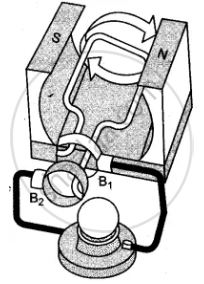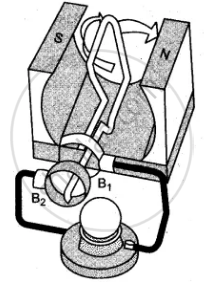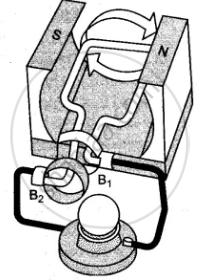Advertisements
Advertisements
प्रश्न
Explain the construction and working of an electric generator (AC) with the help of a neat diagram.
उत्तर
A generator which converts mechanical energy into electrical energy in the form of alternating current is called A.C. generator.
Construction: The main components of A.C. generator are:
- Rectangular coil: A large number of turns of insulated copper wire wound on iron core in rectangular shape form a coil ABCD as shown in the figure.
- Strong magnets: The coil is placed in between two pole pieces (N and S) of a strong magnet. This provides a strong magnetic field.
- Rings: The two ends of the coil are connected to two rings R1 and R2. These rings rotate along with the coil.
- Brushes: Two carbon brushes B1 and B2 are used to press the rings.
- Axle: The two rings have resistive coating in their inner surfaces and are tightly fitted on the axle and the function of the axle is to rotate with the coil.

Working:
- When the axle is rotated with the help of a machine from outside, the coil ABCD starts rotating.
- On rotating the axle, the branch AB move upwards and branch CD move downwards hence coil ABCD rotates clockwise.
- According to Fleming’s right-hand rule, electric current flows in the direction A→B→C→D. Therefore, current flows from B2 to B1 in the external circuit through a galvanometer.
- After half rotation, the branch AB and CD exchange their position and the induced current flows as D→B→A.
- Since, branch BA is in contact with brush B1 and branch DC is in contact with B2, current flow from B1 to B2 in the external circuit i.e., in the direction opposite to the previous half rotation.
- This repeats after every half rotation and in this way, an alternate current is produced using an AC generator.
APPEARS IN
संबंधित प्रश्न
State the principle of an electric generator.
Which sources produce alternating current?
A coil of insulated copper wire is connected to a galvanometer. What will happen if a bar magnet is pushed into the coil?
Name the phenomenon which is made use of in an electric generator.
What change should be made in an a.c. generator so that it may become a d.c. generator?
What is the function of brushes in an electric generator?
The frequency of alternating current (a.c.) supply in India is:
(a) 0 Hz
(b) 50 Hz
(c) 60 Hz
(d) 100 Hz
State whether the following statement are true of false:
A wire with a green insulation is usually the live wire.
The current induced in a closed circuit only if there is ______.
What determines the frequency of a.c. produced in a generator?
What energy conversion does take place in a generator when it is in use?
Explain the construction and working of the following. Draw a neat diagram and label it.
Electric Generator (AC)
Explain the difference:
AC generator and DC generator.
The given figures 1 to 3 show the working of a simple A.C. generator. Study the diagrams and answers of the following questions.



(i) State and explain the principle underlying the working of a simple generator.
(ii) Where is the loop of wire placed?
(iii) What happens when the loop is rotated?
(iv) Indicate the direction of the current flow through the wire for the first half of the turn (in first figure). Name and state the rule used in finding the direction of the current.
(v) Indicate the direction of the current for the case shown in second figure.
(vi) Indicate the direction of current in the outer circuit (i.e., electric bulb) in first and third figure.
(vii) What type of current is shown in the above diagrams? Explain.
Observe the figure and write the answers to the questions asked.

- The construction shown in the figure is of which device?
- Explain the principle on which this device works.
- Write any three uses of this device.
A coil of insulated copper wire is connected to a galvanometer. What will happen if a bar magnet is held stationary inside the coil?
State one factor that affects the magnitude of induced current in an AC generator.
